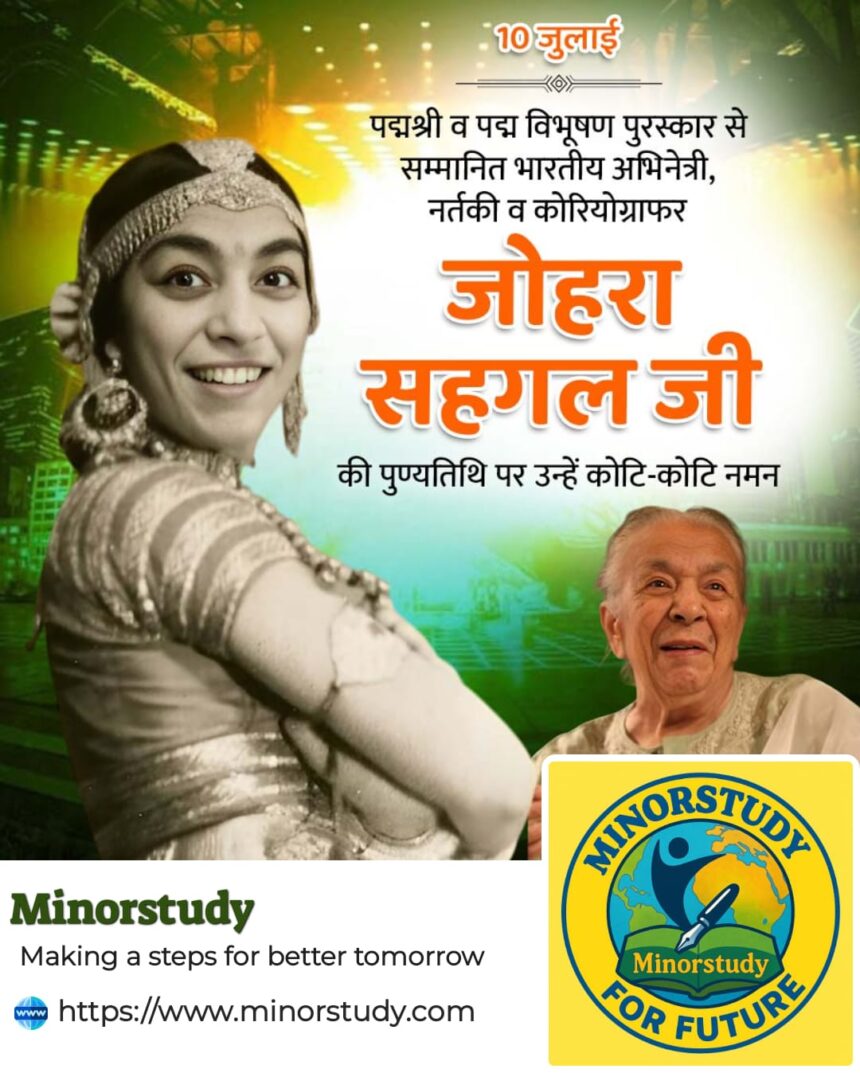🌟 Zohra Sehgal: The Grand Old Lady Who Danced Through Life — History, Impact, Legacy & Significance
“You don’t stop laughing because you grow old; you grow old because you stop laughing.”
– Zohra Sehgal
Zohra Sehgal — a name that radiates charm, wit, resilience, and infectious energy — was more than just an actress or dancer. She was an institution of joy, a pioneer of performing arts, and a woman who challenged age, stereotypes, and societal expectations with unmatched grace and rebellion.
- 🎭 Who Was Zohra Sehgal? An Eternal Firecracker of Expression
- 🗓️ Timeline: The Life Journey of Zohra Sehgal Ji
- 🧠 9 Inspiring Reasons Why Zohra Sehgal’s Legacy Is a Joyful Revolution
- 1. First Indian Woman to Break Cultural Stereotypes
- 2. Pioneer of Indian Modern Dance
- 3. Prithvi Theatre & Progressive Art
- 4. A Career Spanning Eight Decades
- 5. Global Recognition
- 6. Fearless Feminism
- 7. Champion of Secular India
- 8. Unmatched Wit and Spirit
- 9. Inspiration for Generations
- 📚 Key Facts About Zohra Sehgal
- ❓ FAQs About Zohra Sehgal Ji
- 🌸 Wishing Zohra Sehgal Ji — A Humble Salute
- 🎨 Observance & Legacy in Society
- ❤️ Importance in Our Daily Life
- 📌 Key Points to Remember
- 🏁 Conclusion: Why Society Needs More Zohra Sehgal Figures
- 🎉 Final Words — Zohra Sehgal Ji Lives On
From being one of India’s first female theatre performers to becoming a globally admired actress in her 90s, Zohra Sehgal ji’s life is a celebration of courage, art, humor, and eternal youthfulness.
Let’s explore the history, facts, timeline, significance, FAQs, and the profound impact she left on Indian society and our daily lives — all in a warm, human-centric voice that she herself would’ve enjoyed.
🎭 Who Was Zohra Sehgal? An Eternal Firecracker of Expression
Born on 27 April 1912 in Saharanpur, Uttar Pradesh, into a conservative Muslim family, Zohra Sehgal (née Sahibzadi Zohra Begum Mumtaz-ullah Khan) grew up to break every cultural boundary set for women of her time.
A rebel in a veil, a Kathak dancer in British India, and a theatrical force with Prithvi Theatre, Zohra Sehgal redefined what it meant to live life unapologetically, artfully, and joyfully.
🗓️ Timeline: The Life Journey of Zohra Sehgal Ji
| Year | Milestone |
|---|---|
| 1912 | Born in Saharanpur, British India |
| 1930 | Joined Mary Wigman Ballet School in Germany |
| 1935 | Joined Uday Shankar’s dance troupe |
| 1940s | Starred in Prithviraj Kapoor’s Prithvi Theatre |
| 1959 | Moved to London; acted in British TV and films |
| 1970s-80s | Worked with Doordarshan and NSD in India |
| 1990s-2000s | Returned to Bollywood with roles in Dil Se, Hum Dil De Chuke Sanam, etc. |
| 2010 | Awarded the Padma Vibhushan |
| 2014 | Passed away on 10 July in Delhi, at age 102 |
🧠 9 Inspiring Reasons Why Zohra Sehgal’s Legacy Is a Joyful Revolution
1. First Indian Woman to Break Cultural Stereotypes
She studied dance in Germany in the 1930s, rejecting societal expectations. At a time when women were confined to homes, she performed on global stages.
2. Pioneer of Indian Modern Dance
With Uday Shankar, Zohra brought Indian classical and modern dance to global platforms, blending art with intellect.
3. Prithvi Theatre & Progressive Art
She was a key member of Prithviraj Kapoor’s theatre revolution, shaping progressive, social-political theatre in post-colonial India.
4. A Career Spanning Eight Decades
From silent films to Shah Rukh Khan movies, her career proved that art has no expiry date.
5. Global Recognition
She acted in international films like The Jewel in the Crown and Bend It Like Beckham — representing Indian women on global stages with pride and wit.
6. Fearless Feminism
Zohra wore her grey hair like a crown, cracked jokes about death, and never gave in to beauty norms. She made age glamorous.
7. Champion of Secular India
A devout Muslim who worked with Hindus, married a Hindu artist, and performed across religions — she stood for India’s composite culture.
8. Unmatched Wit and Spirit
Her interviews, speeches, and memoirs are filled with laughter, rebellion, and lessons on aging with attitude.
9. Inspiration for Generations
Actors, dancers, and dreamers of every age look up to her as a symbol of fearless living, creativity, and endless curiosity.
📚 Key Facts About Zohra Sehgal
Birth Name: Sahibzadi Zohra Begum Mumtaz-ullah Khan
Birth Date: 27 April 1912
Death Date: 10 July 2014 (aged 102)
Occupation: Dancer, Actress, Theatre Artist
Major Honors: Padma Shri (1998), Padma Bhushan (2002), Padma Vibhushan (2010)
Known For: Theatre, Bollywood, British TV, Stage Dance, Humor
❓ FAQs About Zohra Sehgal Ji
Q1: Was Zohra Sehgal a trained dancer?
Yes, she was trained at the Mary Wigman Ballet School in Germany and was a lead dancer with Uday Shankar’s troupe.
Q2: How many years did her career span?
Her career spanned more than 80 years, from 1935 to 2014 — one of the longest in Indian arts.
Q3: What was her last Bollywood film?
Her last noted performance was in “Cheeni Kum” (2007) opposite Amitabh Bachchan.
Q4: Did she face opposition from her conservative family?
Yes, especially in her early years. But her artistic courage won them over eventually.
Q5: Why is she called the ‘Grand Old Lady of Indian Cinema’?
Because she symbolized grace, longevity, and youthful energy in Indian performing arts — even into her 90s and beyond.
🌸 Wishing Zohra Sehgal Ji — A Humble Salute
“Zohra ji, you taught us how to dance, act, laugh, and live. Your zest made every moment poetic. We bow in gratitude for your glorious century of life.”
🎨 Observance & Legacy in Society
Zohra Sehgal’s legacy is observed through:
Theatre festivals and retrospectives in her honor
Women-centric film seminars showcasing her work
Her life being taught in performing arts curricula
YouTube tributes, documentaries, and even school textbooks now mention her as an icon of liberation
❤️ Importance in Our Daily Life
Zohra Sehgal continues to influence how we:
Challenge ageism and sexism
Laugh at life’s absurdities
Express freely in dance, art, or speech
Stay young in spirit regardless of physical age
Respect cultural diversity in art
Her legacy is not just in movies or books — it lives in every artist, every woman defying odds, and every senior who refuses to fade away.
📌 Key Points to Remember
Zohra Sehgal lived over a century, working with passion till her last breath.
She symbolized artistic courage, secular unity, and liberated womanhood.
She inspired generations of artists and continues to do so.
🏁 Conclusion: Why Society Needs More Zohra Sehgal Figures
Zohra Sehgal proved that one can be fearless, funny, and feminist — all while aging beautifully. Her life is a guide to living fully, loving freely, and laughing always.
In a world battling intolerance, monotony, and superficial beauty, Zohra Sehgal shines as a reminder that truth, art, and joy never grow old.
🎉 Final Words — Zohra Sehgal Ji Lives On
“I have lived life with a dance in my step and a sparkle in my eye. And if that’s how people remember me — I’m more than content.”
And we do, Zohra ji.
With gratitude, admiration, and lots of laughter.








